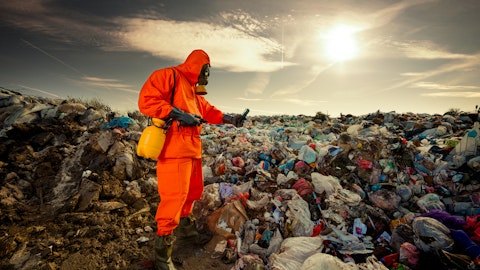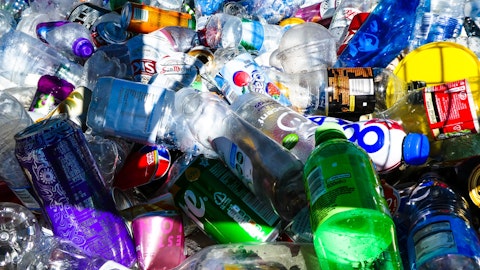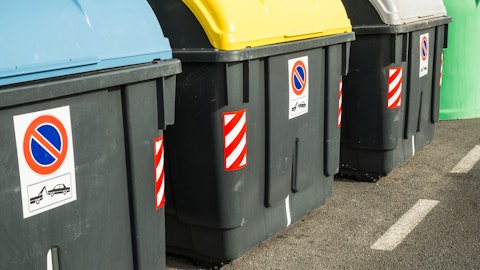Michael Hoffman: Okay. But there are some things like that. Working capital is a pretty healthy use in 2022? Is it assumed neutral? Or do you assume it’s a source in 2023 when I think about the free cash?
Mike Battles: Yes. When you look at free cash flow for 2022, certainly, working capital receivables, inventory, other areas was quite a use. We’re assuming in the guide that we kind of hold the line on working capital, I think that’s going to be a positive. Obviously, if we get better at it and we’re putting a lot of programs in place to get better at managing receivables, getting paid faster. If that gets better, that’s a big win to free cash flow. But we’re assuming that it gets no worse. I think part of the challenge in 2022 was a very large acquisition and the integration around that. And so that was a bit of a headwind in 2022 from a free cash flow perspective as it relates to working capital.
Michael Hoffman: Okay. And then just to be clear, the corporate overhead guide is off the $237 million €“ 3% to 5% growth off the $237 million not normalized, like…
Mike Battles: Yes. We took the actual number, and we assume there’s going to be some €“ the thing when you think of the corporate cost, I think we assume that there’s wage inflation, things like that. There are other cost-saving initiatives that we’re putting in place. Those aren’t in the guide, and we’re hopeful we’ll do better than that.
Michael Hoffman: Okay. Thank you very much.
Mike Battles: Okay, Michael.
Operator: Our next question comes from the line of Noah Kaye with Oppenheimer. Please proceed with your question.
Noah Kaye: Thanks for taking the questions and congratulations to all. Eric, congratulations on the appointment. I guess, Kimball, the $90 million spend increase for 2023, that was always in plan. And so I just want to confirm, a, that you’re re-iterating the budget there. But then I guess we’ve seen just broadly across a number of industries, some delays in terms of large project timing and some CapEx inflation. And so with you reiterating the time line in the budget, can you just talk through for us what drives your confidence and ability to bring the plant online timely, any line of sight to major equipment deliveries, labor ability and so forth?
Eric Gerstenberg: Yes. Noah, this is Eric. I’ll respond to that. So yes, reconfirming the $90 million estimate spend for 2023. The way we look at this project, we obviously have a wealth of experience from how we built out our El Dorado addition, Train 2 and from that, we’ve applied it to the much of the same principle as to how we’re thinking about building out Kimball, how we’ve been building out Kimball. So the components, how we’re managing it, the same management team from a construction, general contractor that we’re using, albeit internally. We’re managing that very closely. We meet monthly and go through the project. We do have some longer lead time items, but those continue to be on track as we went through 2022 and into 2023. So we’re still confident in meeting our start-up date and our start-up timing for that 70,000 tons.
Noah Kaye: Okay. Great. Thanks. And then I just want to make sure I’m clear on how you’re thinking about the SKSS business here in 1Q and kind of the cadence of the year. The comp is still favorable here in 1Q, obviously, it gets tougher as we go later in the year. But it sounds like basically, you’ve accumulated some inventory. There were some impacts from weather, but you can take advantage of the seasonal uptick to sell that through. I guess, how long would you expect to take to work that off? Is that a quarter or two? And then how you think about the sort of the cadence of performance for the segment over the year?
Mike Battles: Yes. Noah, so when you think about kind of the €“ I think that, that inventory get worked off in the first half. March, April, May is kind of a very busy kind of season for the sales of our base and blended products. I think that when you think about the cadence, Q1 will be flattish, maybe up a little bit from last year. Q2 and Q3, given the record quarters we had in the SKSS business, they’re probably going to be down and Q4 will be up given some of the weather challenges we had in Q4 of 2022. So I think the V will be an easier V if you will, in Q4 of 2023. But €“ so I think of the cadence of the year, I think Q1 is flattish Q2, Q3 down, Q4 up.
Noah Kaye: Really helpful. Thank you.
Mike Battles: All right, Noah.
Operator: Our next question comes from the line of Quinn Fredrickson with Baird. Please proceed with your question.
Quinn Fredrickson: Good morning, guys. Thanks for taking my question and congrats to Eric and Brian.
Mike Battles: Hi, Quinn.
Quinn Fredrickson: Yes, congrats to Eric and Brian and best luck to Alan.
Alan McKim: Thank you.





